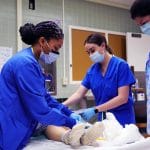The evolution and consequences of synthetic biology
By Laura H. Kahn | April 16, 2007
In the 1970s, genetic engineering was the hot new technology in which DNA molecules from one organism could be spliced into another organism’s DNA. Today, synthetic biology could likewise revolutionize our way of life. But synthetic biology is orders of magnitude beyond genetic engineering because it can create completely novel DNA sequences. By human “intelligent design,” synthetic biologists could conceivably create new life-forms previously unknown to this planet.
Given our current understanding, it’s hard to know whether this is a good or bad thing. But since life-forms–at least the nonsynthetic ones–are typically unpredictable, how can we make sure that synthetic biologists create new life that would be purely beneficial?
One synthetic biologist, Drew Endy, an assistant professor of biological engineering at MIT, is concerned about these issues. He spoke before a Princeton University audience at a Carnegie Corporation International Peace and Security-sponsored biodefense seminar on March 9.
He described some of the biological experiments his undergraduate students have done. For example, three freshman and two sophomores reprogrammed the bacterium Escherichia coli to give off the scent of wintergreen while it grew and multiplied and bananas when senescent. It took them about 16 weeks to do this. Endy estimated that as the technology improves, this work will become easier and faster.
He argued that humans have altered their environment for years by building structures such as houses and bridges with rocks and other materials. Life-forms could be the logical next step in human engineering. However, one could argue that not all human structures have been beneficial to the overall environment: Dams might provide us with hydroelectric power, but they also severely damage the natural landscape.
In addition, engineering new life-forms could have far more devastating consequences because biological ecosystems are interdependent and extremely complex. In 1859, Thomas Austin reportedly released 24 imported wild rabbits on his Australian property so he could continue his hobby–hunting. (Rabbits were not a native species in Australia.) The results of his folly were severe: About one-eighth of all the mammalian species in Australia are now extinct largely due to the rabbits. Also, the rabbits continue to eat many of Australia’s native plant species, causing soil erosion and other serious agricultural problems.
Similarly, the introduction of rabies in the northeastern United States in the mid-1970s is probably due to the translocation of raccoons from the southeast to the northeast for hunting purposes. Since then, the disease has spread northward. The first confirmed case of rabies in raccoons in New York was in 1990. In July 1999, the first case of rabies was detected across the St. Lawrence River in Canada. The spread of this zoonotic disease can be deadly for both animals and humans.
These examples involved the introduction of two well-known animal species (rabbits and raccoons) from one environment into another. The planet’s biological ecosystems have developed over millions of years through competition and mutation so that life-forms fill mutually beneficial niches. Imagine the havoc if a completely new microorganism or animal were introduced to the planet.
In January 2007, ETC Group, an international civil society organization based in Canada, published “Extreme Genetic Engineering,” a report that discusses the concerns that synthetic biologists are creating DNA from scratch without any societal debate or regulatory oversight. This new science, which is a convergence of nanoscale biology, engineering, and computer science, is becoming a global industry with a vested interest to forge ahead in the name of industrial opportunities and capitalism.
The ETC Group argues that there should be a widespread societal debate on the pros and cons of synthetic biology before synthetic biologists convene to decide how to regulate themselves. (Unfortunately, given that a large fraction of society is scientifically illiterate, it might be hard to have a serious and thoughtful societal debate on this issue.)
A 2004 Scientific American article by W. Wayt Gibbs also describes synthetic biology. Gibbs wrote that 30 years ago leading scientists convened a meeting at the Asilomar Conference Grounds in California in which they discussed how they could address the concerns about genetic engineering and the safety of recombinant DNA technology. (There were actually two Asilomars–1973 and 1975–and a 1973 Gordon Conference on Nucleic Acids that focused on the social responsibility of science. All played important roles in developing laboratory biosafety and biocontainment requirements. But I’ll focus here on Asilomar I.)
Endy suggested that perhaps there should be another Asilomar to address concerns about synthetic biology. Why hasn’t there been another Asilomar? What happened 30 years ago that is not happening now?
In 1982, Sheldon Krimsky wrote Genetic Alchemy: The Social History of the Recombinant DNA Controversy, a book which describes the social and intellectual climate that led to the Asilomar conferences. Thirty years ago, there was considerable social unrest, particularly on college campuses, in protest to the Vietnam War. (Today, there is growing opposition to the Iraq War, but not to the same degree as against Vietnam. The difference? The draft. Today, the U.S. military is composed entirely of volunteers, so college students feel largely immune to the Iraq War; therefore, they’ve stayed relatively mute on the issue.)
Krimsky argued that the events on the college campuses 30 years ago were a major influence on those who became the major players in the recombinant DNA debate.
Paul Berg, a Stanford biochemist and Nobel laureate, played a key role in initiating the idea of Asilomar, largely because his proposed work generated concern. Berg was constructing a hybrid molecule using a segment of a bacterial virus’ DNA with the DNA of a cancer-causing animal virus. What would happen if the hybrid accidentally escaped from the laboratory? He decided to postpone his experiment and make some risk-benefit calculations as to whether or not he should proceed.
The focus of Asilomar I was on viruses–particularly those that could produce tumors in animals and/or infections in humans. The National Science Foundation and the National Cancer Institute jointly sponsored Asilomar I, and it was attended by individuals from a wide range of disciplines and government agencies.
The conference had two goals: (1) gather current knowledge of the biohazards presented by viruses; and (2) develop recommendations as to how future experimental work should proceed. The focus was primarily on biosafety.
There were several proposals made at Asilomar I that warranted further consideration but did not receive it. One was the issue of “informed consent”–for the laboratory workers to know the risks of working on the hybrid agents and for the communities in which the research was being conducted. Another was accountability. James Watson, the co-discoverer of the structure of DNA, said it best, “Who gets the benefits, and who bears the risks?”
The main result of Asilomar was the development of the Recombinant DNA Advisory Committee at the National Institutes of Health and the Institutional Biosafety Committees at local institutions that oversee the biosafety and biocontainment of recombinant DNA experiments.
However, the questions we face today are far more complex. We need to revisit some of the proposals made at Asilomar I such as “informed consent” and the scientific community’s accountability to the public. The discussion will not be easy, but it must be done. And to begin the process, we need the next Paul Berg to take the leadership role.
While Endy has expressed interest in the issue, it is unclear if he possesses enough standing in the scientific community to convene a twenty-first century conference to address societal concerns about synthetic biology. It is important to note that he has already organized international synthetic biology meetings that convened scientists who conduct this line of research. The next meeting is scheduled for June 2007 in Zurich.
The first meeting was in 2004 in Boston. It included lectures and some discussions of biological risks.
Two years later, Endy organized a conference in Berkeley, California, that also included discussions on safety, security, and public understanding. Unfortunately, these discussions did not appear to have an impact beyond the confines of the meetings. Endy would do well to partner with a senior scientist with political savvy and lots of connections to make the twenty-first century Asilomar Conference a reality.
Together, we make the world safer.
The Bulletin elevates expert voices above the noise. But as an independent nonprofit organization, our operations depend on the support of readers like you. Help us continue to deliver quality journalism that holds leaders accountable. Your support of our work at any level is important. In return, we promise our coverage will be understandable, influential, vigilant, solution-oriented, and fair-minded. Together we can make a difference.
Topics: Columnists















